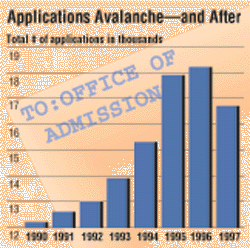Main Menu · Search · Current Issue · Contact · Archives · Centennial · Letters to the Editor · FAQs
![]()
Main Menu ·
Search · Current Issue · Contact · Archives · Centennial · Letters to the Editor · FAQs

|
After increasing 50 percent from 1990 through 1996, the number of applicants for admission to Harvard-Radcliffe declined this year by 8 percent, to about 16,600. An unconcerned William R. Fitzsimmons, dean of admissions and financial aid, describes the drop from last year's record 18,183 applications as "a bit of a return to sanity and realism." Numbers were down at all the Ivy League schools except Columbia, and the Chronicle of Higher Education reported the trend at elite colleges and universities nationwide.
Fitzsimmons cited multiple causes for the decline. He noted that Yale, Princeton, and Stanford, like most other elite schools, have now adopted early-decision programs that require accepted applicants to attend. "When more schools go to early decision," Fitzsimmons says, "fewer applicants will be around" to apply elsewhere, because competing colleges pursue the same top students. Moreover, the move to earlier applications itself narrows the pool of prospects. If a high school's top-ranked students apply early and are deferred until spring, or rejected, Fitzsimmons explains, that sends a message to "marginal" applicants.
Fitzsimmons also speculates that the applications bulge may have been artificially prolonged by the "recentering" of aptitude tests in 1995-1996. That adjustment raised average verbal and mathematics scores by 70 and 30 points, respectively. As a result, he says, Harvard saw "more unrealistic applications." Because College admissions officers look well beyond test scores and the statistical legerdemain that drove them up, however, the same kinds of applicants were accepted as in prior years.
Despite the decline in applicants, Harvard appears committed to early action, instead of early decision, in choosing its freshman class. (This option grants applicants admission, but does not require a commitment to attend.) Fitzsimmons sees advantages for both sides: prospective students have more time to make up their minds, and a chance to compare financial aid offers; and Harvard, at least partly in return, has the "highest graduation rate in the country," averaging more than 96 percent.
If the new norm is fewer applications, the class of 2000 can take smug satisfaction in knowing they are the most select group of Harvardians ever: last year, only 10.9 percent of applicants got in. This year, 2,040 applicants--12.3 percent of the total--were offered admission to the slightly larger class of 2001 (see "A Shift in Admissions," page 65).
Not that the newcomers are slouches. More than half the applicants scored 1400 or above on their combined SATs, and the number of high-school valedictorians who applied (2,672) again handily exceeded the number of acceptances.
A final note about those admitted: 48.5 percent are women, a record high.
Main Menu ·
Search · Current Issue · Contact · Archives · Centennial · Letters to the Editor · FAQs
![]()